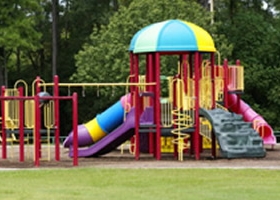Article at a Glance
• Take time to inspect your local park for any potential safety issues.
• Things like improper surfacing, broken equipment, or design issues can contribute to serious injuries.
• Make sure playground equipment is age appropriate for your child.
The playground can be a wonderful place for your children to get exercise and interact with other children. However, 200,000 children are treated in hospital emergency rooms for playground injuries every year. This doesn’t mean you should stop taking your children to the park, but it’s a reminder that you should review your playground for any safety issues. Here’s a quick checklist you can print off and take to the park with you next time.
![]() Surface Areas: Don’t allow your children to use playground surfaces made out of concrete, asphalt, blacktop, grass, or dirt. Look for playgrounds that have surfaces loosely filled with wood chips, mulch, sand, pea gravel, or shredded rubber. Surface mats made of rubber-like materials are also safe. The cushioned area needs to be at least six feet past the playground equipment. A cushioned surface will help soften the impact of a child’s fall and reduce serious injuries.
Surface Areas: Don’t allow your children to use playground surfaces made out of concrete, asphalt, blacktop, grass, or dirt. Look for playgrounds that have surfaces loosely filled with wood chips, mulch, sand, pea gravel, or shredded rubber. Surface mats made of rubber-like materials are also safe. The cushioned area needs to be at least six feet past the playground equipment. A cushioned surface will help soften the impact of a child’s fall and reduce serious injuries.
 Potential Hazards: Scan the playground for any potential hazards like broken glass, twisted metal, or items a child could trip over. Look for spaces in the equipment that could trap a child’s arm or head. If there are any moving parts, look for areas that could pinch or crush a child’s hand.
Potential Hazards: Scan the playground for any potential hazards like broken glass, twisted metal, or items a child could trip over. Look for spaces in the equipment that could trap a child’s arm or head. If there are any moving parts, look for areas that could pinch or crush a child’s hand.
 Age Groups: Make sure the playground is appropriate for the age of your child. In newer parks, equipment is generally labeled for either infants and toddlers (under 2), preschoolers (2-5), or school-age kids (5-12).
Age Groups: Make sure the playground is appropriate for the age of your child. In newer parks, equipment is generally labeled for either infants and toddlers (under 2), preschoolers (2-5), or school-age kids (5-12).
 Guardrails: Platforms, ramps, or other elevated surfaces should be surrounded by guardrails.
Guardrails: Platforms, ramps, or other elevated surfaces should be surrounded by guardrails.
 Maintenance: Make sure the playground is in good repair. Check for broken equipment, cracked or splinter wood, rusted metal, or loose parts. Report any problems immediately.
Maintenance: Make sure the playground is in good repair. Check for broken equipment, cracked or splinter wood, rusted metal, or loose parts. Report any problems immediately.
 Swings: Swings should be made out of materials like rubber or plastic, not wood or metal. There should only be two swings per bay and they should be at least 24 inches apart.
Swings: Swings should be made out of materials like rubber or plastic, not wood or metal. There should only be two swings per bay and they should be at least 24 inches apart.
 Seesaws and Merry-Go-Rounds: Seesaws (without a spring-centering device) and merry-go-rounds can be dangerous and shouldn’t be used by children under the age of five. Use additional caution if you allow your children to play on this equipment.
Seesaws and Merry-Go-Rounds: Seesaws (without a spring-centering device) and merry-go-rounds can be dangerous and shouldn’t be used by children under the age of five. Use additional caution if you allow your children to play on this equipment.
 Fencing: Make sure there is a fence in place to keep children from running into the street.
Fencing: Make sure there is a fence in place to keep children from running into the street.
 Adult Supervision: Make sure you can see your children clearly from benches or other sitting areas. Most accidents occur when a child plays on playground equipment inappropriately or while roughhousing. Adult supervision can help keep kids in check.
Adult Supervision: Make sure you can see your children clearly from benches or other sitting areas. Most accidents occur when a child plays on playground equipment inappropriately or while roughhousing. Adult supervision can help keep kids in check.
 Unsafe Equipment: Don’t allow your child to play on animal figure swings, glider swings, swinging ropes, exercise rings, trapeze bars, monkey bars, or trampolines.
Unsafe Equipment: Don’t allow your child to play on animal figure swings, glider swings, swinging ropes, exercise rings, trapeze bars, monkey bars, or trampolines.
For more information:
Playground Safety (KidsHealth.org)
Playground Safety Publications (U.S. Consumer Product Safety Commission)
